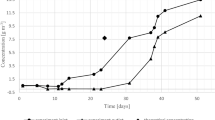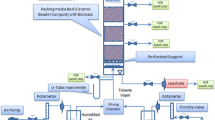Abstract
We have solved both steady state and transient problems on the biofiltration of toluene vapor. The effect of inlet toluene concentration and inlet gas-flow rate on the removal rate of toluene and the elimination capacity of a lab-scale biofilter has been investigated. In this study, the effectiveness factor was a function of pollutant concentration. The dynamic solutions show good agreement with experimental results. At an inlet toluene concentration of 100 ppm, the diffusion of toluene into biofilm was obviously a rate determining step. Above 200 ppm, however, biofilm already showed full activity. The steady-state simulation confirmed that the change of elimination capacity obtained by increasing only inlet toluene concentration was the same as that obtained by increasing only flow rate of contaminated air. The maximum possible performance is about 20 g/m3h with no addition of nutrients.
Similar content being viewed by others
References
Abumaizar, R. J., Smith, E. H. and Kocher, W., “Analytical Model of Dual-media Biofilter for Removal of Organic Air Pollutants,”J. Environ. Eng. Div. (Am. Soc. Civ. Eng.),123(6), 606 (1997).
Amanullah, Md., Farooq, S. and Viswanathan, S., “Modeling and Simulation of a Biofilter,”Ind. Eng. Chem. Res.,38, 2765 (1999).
Baider, F. G., “Kinetics of Double-substrate-limited Growth,” In Microbial Population Dynamics, Bazin, M. J., CRC Press, Boca Raton, FL (1982).
Chaudhary, D. S., Vigneswaran, S. and Ngo, H. H., “Biofilter in Water and Wastewater Treatment,”Korean J. Chem. Eng.,20, 1054 (2003).
Deshusses, M. A, Hamer, G. and Dunn, I. J., “Behavior of Biofilters for Waste Air Biotreatment. 1. Dynamic Model Development,”Environ. Sci. Technol.,29(4), 1048 (1995).
Devinny, J. S., Deshusses, M. A. and Webster, T. S., “Biofiltration for air Pollution Control“ Lewis publishers, Washington D.C. (1999).
Diks, R. M. M. and Ottengraf, S. P. P., “Verification Studies of a Simplified Model for Removal of Dichloromethane from Waste Gases using a Biological Trickling Filter,”Bioprocess Engng.,6, 93 (1991).
Fan, L. S., Leyva-Ramos, R, Wisecarver, K D. and Zehner, B. J., “Diffusion of Phenol through a Biofilm grown on Activated Carbon Particles in a Draft-tube Three-phase Fluidized-bed Bioreactor,”Biotechnol. Bioeng.,35, 279 (1990).
Hodge, D. S. and Devinny, J. S., “Modeling Removal of Air Contaminants by Biofiltration,”J. Environ. Eng. Div. (Am. Soc. Civ. Eng.),121(1), 21 (1995).
Jennings, P. A., Snoeyink, V. L. and Chian, E. S. K, “Theoretical Model for a Submerged Biological Filter,”Biotechnol. Bioeng.,18, 1249 (1976).
Lim, K H. and Lee, E. J., “Biofilter Modeling for Waste Air Treatment: Comparisons of Inherent Characteristics of Biofilter Models,”Korean J. Chem. Eng.,20, 315 (2003).
Oh, K J., Kim, Y. S. and Cho, S. K, “Degradation of Benzene and Toluene by a Fluidized Bed Bioreactor Including Microbial Consortium,”Korean J. Chem. Eng.,19, 1026 (2002).
Ottengraf, S. P. P., “Theoretical Model for a Submerged Biological Filter,”Biotechnol. Bioengng.,19, 1411 (1977).
Shareefdeen, Z, Baltzis, B. C., Oh, Y. S. and Bartha, R., “Biofiltration of Methanol Vapor,”Biotechnol. Bioengng,41, 512 (1993).
Shareefdeen, Z. and Baltzis, B. C., “Biological Removal of Hydrophobie Solvent Vapors from Airstreams“ In Advances in bioprocess engineering, Galindo, E., Ramirez, O. T, Eds., Kluwer Academic Publishers, Dordrecht, The Netherlands (1994).
Shareefdeen, Z. and Baltzis, B. C, “Biofiltration of Toluene Vapor under Steady-state and Transient Conditions: Theory and Experimental Results,”Chem. Eng. Sci.,49, 4347 (1994).
Yoon, I-K, Kim, C.-N. and Park, C.-H., “Optimum Operating Conditions for the Removal of Volatile Organic Compounds in a Compost-Packed Biofilter,”Korean J. Chem. Eng.,19, 954 (2002).
Zarook, S. M. and Shaikh, A. A., “Analysis and Comparison of Biofilter Models,”Chem. Eng. J.,65, 55 (1997).
Author information
Authors and Affiliations
Corresponding author
Rights and permissions
About this article
Cite this article
Choi, HS., Myung, SW. Numerical and experimental study on the biofiltration of toluene vapor. Korean J. Chem. Eng. 21, 680–688 (2004). https://doi.org/10.1007/BF02705505
Received:
Accepted:
Issue Date:
DOI: https://doi.org/10.1007/BF02705505




